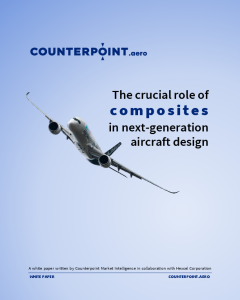The lightweight, adaptable nature of our innovative materials enables our customers to design products that are lighter, stronger, and more durable as carbon fiber is 5X stronger and 30% lighter than aluminum.
Each new generation of commercial aircraft are using increasing quantities of advanced composites to replace metals and reduce weight for more fuel-efficient aircraft that then emit less CO2. Every kilogram of fuel saved by an aircraft reduces CO2 emissions by more than three kilograms1.
Moreover, composite-based parts do not corrode and are stronger, leading to longer-life and increased safety and performance. Longer-life parts reduce operating costs and are more environmentally friendly compared to parts that corrode or fatigue and need replacement. Consequently, our composites provide a lower lifecycle cost to aircraft owners and operators than competing materials.
For applications that fly, composites enable complex and innovative aerodynamic designs that can’t be undertaken with metal such as longer, thinner and more wind-swept aircraft wings or more complex part designs.
Therefore, our beneficial impact to global emissions reduction is closely linked with our customers using our lightweighting solutions to reduce the impact on the environment by the aircraft and other transportation products they produce. Whether the goal is to reduce fuel consumption, minimize total lifecycle operating and maintenance costs or lessen engine noise . . . Hexcel’s lightweight composites are integral to the product design.
- The composite-rich Airbus A350 provides a 25% advantage in fuel burn, operating costs and CO2 emissions compared to previous generation aircraft2.
- Similarly, the composite-rich Boeing 787 has 25% fewer CO2 emissions compared to the aircraft it replaced3.
- Composite wing-tip extensions, such as those made by Hexcel, enhance fuel efficiency by improving airflow around the wing. For example, the Airbus A320 benefits with up to a 4% fuel efficiency improvement, reducing CO2 emissions by 900 tons annually per aircraft.4
- Composite aircraft require fewer maintenance checks than metal aircraft as composites don’t corrode or suffer metal fatigue. The composite-intensive A350 requires 50% fewer structure maintenance tasks, and the threshold for airframe checks is twelve years, compared to eight for the A380, which has a metal fuselage and metal wings.5

The crucial role of composites in next-generation
aircraft design white paper

Airbus A350 with winglets
- The LEAP engine uses lightweight and durable carbon fiber fan blades, leading to a 500-pound weight reduction per engine and a 15% improvement in fuel economy compared to predecessor metal fan blades.6
- Hexcel’s HexWeb® Acousti-Cap® sound attenuating honeycomb provides dramatic noise reduction during takeoff and landing without a structural weight penalty, such as a 40% noise reduction in the engine of the Boeing 737 MAX compared to its predecessor.7

Honeycomb HexWeb® Acousti-Cap®
- Composite fuselages on the Boeing 787 and Airbus A350 allow the cabin to be pressurized and humidified to a greater degree than metal fuselages, which can help to reduce passenger jet lag thereby improving the customer experience.8
Read more about Our Commitment to Sustainability: Hexcel Sustainability
References
- IATA: https://www.iata.org/contentassets/922ebc4cbcd24c4d9fd55933e7070947/icop_faq_general-for-airline-participants.pdf (refer to pages 8 and 9)
- Airbus: https://www.airbus.com/en/products-services/commercial-aircraft/passenger-aircraft/a350-family
And
Table 1, pg. 15 IATA Aircraft technology roadmap to 2050:
https://www.iata.org/en/programs/environment/technology-roadmap/
- Boeing: https://www.boeing.com/commercial/787#family
- Airbus: https://www.airbus.com/en/newsroom/press-releases/2013-10-airbus-launches-sharklet-retrofit-for-in-service-a320-family
- Airbus: https://www.airbus.com/en/newsroom/news/2017-08-composites-airbus-continues-to-shape-the-future
And
Boeing highlights “zero evidence of composite airframe fatigue” on in-service 787’s from routine maintenance checks, per pg. 2
https://www.boeing.com/content/dam/boeing/boeingdotcom/features/innovation-quarterly/2024/01/IQ2024Q3The787DreamlinerDifference.pdf
- CFM: https://www.cfmaeroengines.com/leap
- Boeing Company: https://boeing.mediaroom.com/2016-06-03-Boeing-reports-environmental-progress
- Quartz: https://qz.com/quartzy/1246492/how-to-avoid-jetlag-book-flights-on-a350-and-787-planes